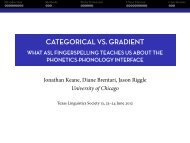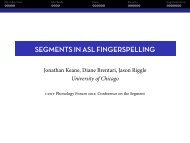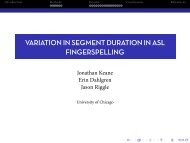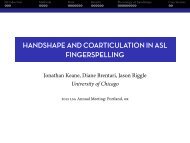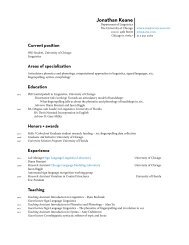Handshape assimilation in ASL fingerspelling ... - Jonathan Keane
Handshape assimilation in ASL fingerspelling ... - Jonathan Keane
Handshape assimilation in ASL fingerspelling ... - Jonathan Keane
- No tags were found...
Create successful ePaper yourself
Turn your PDF publications into a flip-book with our unique Google optimized e-Paper software.
Introduction Methods Ulnar Flexion ConclusionsBroad QuestionsHow do handshapes <strong>in</strong> f<strong>in</strong>gerspell<strong>in</strong>g, and <strong>ASL</strong> broadly, vary, andwhat causes this variation?▸ environment?▸ signer?▸ phonological properties?Objectives of this research▸ Analyze a large corpus of f<strong>in</strong>gerspell<strong>in</strong>g data us<strong>in</strong>g a variety ofmanual, automated, and statistical techniques.▸ Quantify and <strong>in</strong>vestigate the sources of variation with<strong>in</strong>f<strong>in</strong>gerspell<strong>in</strong>g.▸ Develop an articulatory model of handshape.
Introduction Methods Ulnar Flexion ConclusionsA basic description of f<strong>in</strong>gerspell<strong>in</strong>g▸ F<strong>in</strong>gerspell<strong>in</strong>g is a type of loanword system that makes upanywhere from 12–35% of <strong>ASL</strong> discourse (Padden, 1991; Paddenand Gunsauls, 2003).▸ Simplistically, f<strong>in</strong>gerspell<strong>in</strong>g is a set of static (except for -J- and-Z-) handshape-orientation comb<strong>in</strong>ations strung togethersequentially, where each maps to one letter <strong>in</strong> an English word.▸ Many note that this description is not quite accurate (Wilcox(1992); Akamatsu (1982) &c.).a b c d e fjz
Introduction Methods Ulnar Flexion ConclusionsStructure of the <strong>ASL</strong> lexiconnativeadapted from Brentari and Padden (2001); Battison (1978)
Introduction Methods Ulnar Flexion ConclusionsStructure of the <strong>ASL</strong> lexiconnativespatialadapted from Brentari and Padden (2001); Battison (1978)
Introduction Methods Ulnar Flexion ConclusionsStructure of the <strong>ASL</strong> lexiconcorenativespatialadapted from Brentari and Padden (2001); Battison (1978)
Introduction Methods Ulnar Flexion ConclusionsStructure of the <strong>ASL</strong> lexiconcorenativespatialforeignother SLsadapted from Brentari and Padden (2001); Battison (1978)
Introduction Methods Ulnar Flexion ConclusionsStructure of the <strong>ASL</strong> lexiconforeignf<strong>in</strong>gerspell<strong>in</strong>gcorenativespatialforeignother SLsadapted from Brentari and Padden (2001); Battison (1978)
Introduction Methods Ulnar Flexion ConclusionsStructure of the <strong>ASL</strong> lexiconneutral f<strong>in</strong>gerspell<strong>in</strong>gforeignf<strong>in</strong>gerspell<strong>in</strong>gfully assimilated loan signsnativecore spatialforeignother SLsadapted from Brentari and Padden (2001); Battison (1978)
Introduction Methods Ulnar Flexion ConclusionsStructure of the <strong>ASL</strong> lexiconneutral f<strong>in</strong>gerspell<strong>in</strong>gforeignf<strong>in</strong>gerspell<strong>in</strong>gfully assimilated loan signsnativecore spatialfully assimilated loan signseg NOforeignother SLsadapted from Brentari and Padden (2001); Battison (1978)
Introduction Methods Ulnar Flexion ConclusionsStructure of the <strong>ASL</strong> lexiconneutral f<strong>in</strong>gerspell<strong>in</strong>gforeignf<strong>in</strong>gerspell<strong>in</strong>gfully assimilated loan signsnativecore spatial<strong>in</strong>itialized signseg TEAMforeignother SLsadapted from Brentari and Padden (2001); Battison (1978)
Introduction Methods Ulnar Flexion ConclusionsStructure of the <strong>ASL</strong> lexiconneutral f<strong>in</strong>gerspell<strong>in</strong>gforeignf<strong>in</strong>gerspell<strong>in</strong>gfully assimilated loan signsnativecore spatialtwo FS-letter loanseg WORKSHOPforeignother SLsadapted from Brentari and Padden (2001); Battison (1978)
Introduction Methods Ulnar Flexion ConclusionsStructure of the <strong>ASL</strong> lexiconneutral f<strong>in</strong>gerspell<strong>in</strong>gforeignf<strong>in</strong>gerspell<strong>in</strong>gfully assimilated loan signsnativecore spatialpartially assimilated loansignseg #EARLYforeignother SLsadapted from Brentari and Padden (2001); Battison (1978)
Introduction Methods Ulnar Flexion ConclusionsStructure of the <strong>ASL</strong> lexiconneutral f<strong>in</strong>gerspell<strong>in</strong>gforeignf<strong>in</strong>gerspell<strong>in</strong>gfully assimilated loan signsnativecore spatialneutral f<strong>in</strong>gerspell<strong>in</strong>geg F-R-E-Eforeignother SLsadapted from Brentari and Padden (2001); Battison (1978)
Introduction Methods Ulnar Flexion ConclusionsWhy neutral f<strong>in</strong>gerspell<strong>in</strong>g?F<strong>in</strong>gerspell<strong>in</strong>g <strong>in</strong>volves quick and sequential handshape changes,unlike sign<strong>in</strong>g.Which results <strong>in</strong> an ideal data set to look at variation <strong>in</strong> handshapebecause there are▸ a large number of <strong>in</strong>dividual tokens▸ <strong>in</strong> a huge variety of contexts▸ us<strong>in</strong>g (most of) the handshapes <strong>in</strong> <strong>ASL</strong>
Introduction Methods Ulnar Flexion ConclusionsUlnar flexionWe def<strong>in</strong>ed ulnar flexion variants as apogees where either theproximal <strong>in</strong>terphalangeal or the metacarpophalangeal jo<strong>in</strong>t was moreflexed <strong>in</strong> ulnar digits than radial digits.-O- [+flex] -O- [−flex] -E- [+flex] -E- [−flex] -D- [+flex] -D- [−flex]Apogees from A-U-T-H-O-R-I-T-Y, C-O-U-P-L-E, I-N-T-E-R-E-S-T, D-E-C-I-S-I-O-N,G-R-O-U-N-D, and D-A-Y-S,
Introduction Methods Ulnar Flexion ConclusionsUlnar flexionWe def<strong>in</strong>ed ulnar flexion variants as apogees where either theproximal <strong>in</strong>terphalangeal or the metacarpophalangeal jo<strong>in</strong>t was moreflexed <strong>in</strong> ulnar digits than radial digits.-O- [+flex] -O- [−flex] -E- [+flex] -E- [−flex] -D- [+flex] -D- [−flex]Apogees from A-U-T-H-O-R-I-T-Y, C-O-U-P-L-E, I-N-T-E-R-E-S-T, D-E-C-I-S-I-O-N,G-R-O-U-N-D, and D-A-Y-S,
Introduction Methods Ulnar Flexion ConclusionsUlnar flexionWe def<strong>in</strong>ed ulnar flexion variants as apogees where either theproximal <strong>in</strong>terphalangeal or the metacarpophalangeal jo<strong>in</strong>t was moreflexed <strong>in</strong> ulnar digits than radial digits.-O- [+flex] -O- [−flex] -E- [+flex] -E- [−flex] -D- [+flex] -D- [−flex]Apogees from A-U-T-H-O-R-I-T-Y, C-O-U-P-L-E, I-N-T-E-R-E-S-T, D-E-C-I-S-I-O-N,G-R-O-U-N-D, and D-A-Y-S,
Introduction Methods Ulnar Flexion ConclusionsData collectionRecord<strong>in</strong>g specifications▸ 4 native signers, 1 early leaner (2 (native) coded so far) produced▸ 300 words▸▸▸100 names100 nouns100 non-English words▸ repeat<strong>in</strong>g each word twice▸ be<strong>in</strong>g recorded by 2 or 3 video cameras▸ record<strong>in</strong>g at 60 FPS▸ for a total of 8,115 apogees
Introduction Methods Ulnar Flexion ConclusionsCod<strong>in</strong>g methodApogee detectionWe used a comb<strong>in</strong>ation of human coders, algorithmic averag<strong>in</strong>g,forced alignment, and verification to code tim<strong>in</strong>g data.Apogees▸ are the po<strong>in</strong>t where the hand reached a target handshape andorientation, or▸ the po<strong>in</strong>t of m<strong>in</strong>imum <strong>in</strong>stantaneous velocity of all of thearticulators, but▸ crucially are not def<strong>in</strong>ed as the canonical form.(<strong>Keane</strong> et al., 2011)
Introduction Methods Ulnar Flexion ConclusionsCod<strong>in</strong>g methodFeature annotationFeature annotation▸ We extracted still images from each apogee that has been coded.▸ We human coded features of hand configuration:▸ all -C-, -D-, -E-, and -O- apogees for ulnar flexion.▸ There are 4,741 word medial apogees annotated.Two goals▸ A simple task with only a m<strong>in</strong>imal amount of tra<strong>in</strong><strong>in</strong>g necessary▸ A metric that would apply regardless of how canonical a givenhandshape was
Introduction Methods Ulnar Flexion ConclusionsDescription<strong>Handshape</strong> variationc d e o400300count2001000canonical +flexion canonical +flexion canonical +flexion canonical +flexionhandshape variant
Introduction Methods Ulnar Flexion ConclusionsDescription<strong>Handshape</strong> variationc d e o400300count2001000canonical +flexion canonical +flexion canonical +flexion canonical +flexionhandshape variant
Introduction Methods Ulnar Flexion ConclusionsCondition<strong>in</strong>g VariablesWhat features encourage ulnar digit flexion?Selected F<strong>in</strong>gers▸ are described as the most salient f<strong>in</strong>gers for a given handshape,▸ are often (but not always!) extended, with other f<strong>in</strong>gers (more)flexed,▸ are used by many models of sign language phonology.one f<strong>in</strong>ger two f<strong>in</strong>gers three f<strong>in</strong>gers-G-, -L-, -Q-,-T-, -X-, and-Z--M-, -W-, and-Dallf<strong>in</strong>gers-A-, -B-, -C-,-E-, -O-, and-S--H-, -K-, -N-,-P-, -R-, -U-,and -V-others (ulnar)-F-, -I-, -J-,and -Y-
Introduction Methods Ulnar Flexion ConclusionsCondition<strong>in</strong>g VariablesWhat features encourage ulnar digit flexion?Selected F<strong>in</strong>gers▸ are described as the most salient f<strong>in</strong>gers for a given handshape,▸ are often (but not always!) extended, with other f<strong>in</strong>gers (more)flexed,▸ are used by many models of sign language phonology.one f<strong>in</strong>ger two f<strong>in</strong>gers three f<strong>in</strong>gers-G-, -L-, -Q-,-T-, -X-, and-Z--M-, -W-, and-Dallf<strong>in</strong>gers-A-, -B-, -C-,-E-, -O-, and-S--H-, -K-, -N-,-P-, -R-, -U-,and -V-others (ulnar)⎫⎪⎬⎪⎭-F-, -I-, -J-,and -Yradial:[−flex](>extension)ulnar: [+flex]
Introduction Methods Ulnar Flexion ConclusionsCondition<strong>in</strong>g VariablesWhat features encourage ulnar digit flexion?Selected F<strong>in</strong>gers▸ are described as the most salient f<strong>in</strong>gers for a given handshape,▸ are often (but not always!) extended, with other f<strong>in</strong>gers (more)flexed,▸ are used by many models of sign language phonology.one f<strong>in</strong>ger two f<strong>in</strong>gers three f<strong>in</strong>gers-G-, -L-, -Q-,-T-, -X-, and-Z--M-, -W-, and-Dallf<strong>in</strong>gers-A-, -B-, -C-,-E-, -O-, and-S--H-, -K-, -N-,-P-, -R-, -U-,and -V-others (ulnar)⎫⎪⎬⎪⎭⎫⎪⎬⎪⎭-F-, -I-, -J-,and -Yradial:[−flex](>extension)ulnar: [+flex]all: [±flex]orradial: [+flex]ulnar: [−flex]
Introduction Methods Ulnar Flexion ConclusionsCondition<strong>in</strong>g VariablesWhat features encourage ulnar digit flexion?Selected F<strong>in</strong>gers▸ are described as the most salient f<strong>in</strong>gers for a given handshape,▸ are often (but not always!) extended, with other f<strong>in</strong>gers (more)flexed,▸ are used by many models of sign language phonology.one f<strong>in</strong>ger two f<strong>in</strong>gers three f<strong>in</strong>gers-G-, -L-, -Q-,-T-, -X-, and-Z--M-, -W-, and-Dallf<strong>in</strong>gers-A-, -B-, -C-,-E-, -O-, and-S--H-, -K-, -N-,-P-, -R-, -U-,and -V-others (ulnar)⎫⎪⎬⎪⎭⎫⎪⎬⎪⎭-F-, -I-, -J-,and -Ycondition<strong>in</strong>gnoncondition<strong>in</strong>g
Introduction Methods Ulnar Flexion ConclusionsCondition<strong>in</strong>g VariablesFlexion based on surround<strong>in</strong>g handshapeshandshape − immediately follow<strong>in</strong>gcondition<strong>in</strong>gnoncondition<strong>in</strong>gpercent +flex●●●●●●0.000.050.100.150.200.25noncondition<strong>in</strong>gcondition<strong>in</strong>ghandshape − immediately previous
Introduction Methods Ulnar Flexion ConclusionsCondition<strong>in</strong>g VariablesWhat effects the -E- handshape?-I- -N- -T- -E- -R- -E- -S- -T-
Introduction Methods Ulnar Flexion ConclusionsCondition<strong>in</strong>g VariablesWhat effects the -E- handshape?-I- -N- -T- -E- -R- -E- -S- -Tapogeehandshape
Introduction Methods Ulnar Flexion ConclusionsCondition<strong>in</strong>g VariablesWhat effects the -E- handshape?word typename, noun, foreignsigners1, s2-I- -N- -T- -E- -R- -E- -S- -Tapogeehandshape
Introduction Methods Ulnar Flexion ConclusionsCondition<strong>in</strong>g VariablesWhat effects the -E- handshape?word typename, noun, foreignsigners1, s2previous handshape-I- -N- -T- -E- -R- -E- -S- -Tapogeehandshape
Introduction Methods Ulnar Flexion ConclusionsCondition<strong>in</strong>g VariablesWhat effects the -E- handshape?word typename, noun, foreignsigners1, s2previous handshapeprevious transition time-I- -N- -T- -E- -R- -E- -S- -Tapogeehandshape
Introduction Methods Ulnar Flexion ConclusionsCondition<strong>in</strong>g VariablesWhat effects the -E- handshape?word typename, noun, foreignsigners1, s2previous handshapefollow<strong>in</strong>g handshapeprevious transition time-I- -N- -T- -E- -R- -E- -S- -Tapogeehandshape
Introduction Methods Ulnar Flexion ConclusionsCondition<strong>in</strong>g VariablesWhat effects the -E- handshape?word typename, noun, foreignsigners1, s2previous handshapeprevious transition timefollow<strong>in</strong>g handshapefollow<strong>in</strong>g transition time-I- -N- -T- -E- -R- -E- -S- -Tapogeehandshape
Introduction Methods Ulnar Flexion ConclusionsCondition<strong>in</strong>g VariablesSignificant effects for ulnar flexionword typename, noun, non-Englishsigners1, s2previous handshape<strong>in</strong>teractionprevious transition timefollow<strong>in</strong>g handshape<strong>in</strong>teractionfollow<strong>in</strong>g transition timeapogee handshape(<strong>Keane</strong> et al., 2012)
Introduction Methods Ulnar Flexion ConclusionsCondition<strong>in</strong>g VariablesSignificant effects for ulnar flexionword typename, noun, non-Englishsigners1, s2previous handshape<strong>in</strong>teractionprevious transition timefollow<strong>in</strong>g handshape<strong>in</strong>teractionfollow<strong>in</strong>g transition timeapogee handshape(<strong>Keane</strong> et al., 2012)
Introduction Methods Ulnar Flexion ConclusionsCondition<strong>in</strong>g VariablesModel predictions for ulnar flexion (mean transition times)1.0eoprobability of ulnar digit flexion0.80.60.40.20.0●●●●●●●●number ofcondition<strong>in</strong>ghandshapes●●noneone● twoneither previousfollow<strong>in</strong>g both neither previousfollow<strong>in</strong>g bothcondition<strong>in</strong>g handshape position
Introduction Methods Ulnar Flexion ConclusionsExplanationCondition<strong>in</strong>g features▸ Increased ulnar digit flexion occurs <strong>in</strong> the context of surround<strong>in</strong>gapogees with handshapes that have extended radial f<strong>in</strong>gers andflexed ulnar f<strong>in</strong>gers.▸ It seems that flexed, nonselected ulnar f<strong>in</strong>gers are spread<strong>in</strong>g fromsurround<strong>in</strong>g apogees to -E- and -O-.-T- -E- -R- -R- -O- -U-Apogees from I-N-T-E-R-E-S-T and T-R-O-U-B-L-E
Introduction Methods Ulnar Flexion ConclusionsExplanationCondition<strong>in</strong>g features▸ Increased ulnar digit flexion occurs <strong>in</strong> the context of surround<strong>in</strong>gapogees with handshapes that have extended radial f<strong>in</strong>gers andflexed ulnar f<strong>in</strong>gers.▸ It seems that flexed, nonselected ulnar f<strong>in</strong>gers are spread<strong>in</strong>g fromsurround<strong>in</strong>g apogees to -E- and -O-.-T- -E- -R- -R- -O- -U-Apogees from I-N-T-E-R-E-S-T and T-R-O-U-B-L-E
Introduction Methods Ulnar Flexion ConclusionsSelected f<strong>in</strong>ger quantity <strong>assimilation</strong>Condition<strong>in</strong>g nonselected f<strong>in</strong>gers? Really?Alternatively, the selected f<strong>in</strong>gers specification assimilates fromsurround<strong>in</strong>g apogees, to apogees that are underspecified for selectedf<strong>in</strong>gers (ie [all]).▸ Many phonological theories of handshape use underspecification,especially for [all] selected f<strong>in</strong>gers.▸ Underspecified features are traditionally assumed to be the mostsusceptible to <strong>assimilation</strong> (cf alveolar nasals).▸ A similar phenomenon has been observed <strong>in</strong> sign errors (egMUST SEE (Klima and Bellugi, 1979)).
Introduction Methods Ulnar Flexion ConclusionsSelected f<strong>in</strong>ger quantity <strong>assimilation</strong>Push<strong>in</strong>g the boundariesBecause of underspecification, handshapes that have [all] f<strong>in</strong>gersselected should be more susceptible to <strong>assimilation</strong>.Of the [all] f<strong>in</strong>gers selected handshapes:▸ -E- and -O- show variation.▸ -A- and -S- show no variation, but all f<strong>in</strong>gers completely flexed.▸ -C- shows little variation, but this could be physiological, (CFlexical handshape contours).▸ -B- (seem<strong>in</strong>gly) shows no variation, has all f<strong>in</strong>gers extended, thismight be physiological or phonological block<strong>in</strong>g (EG -U-).
Introduction Methods Ulnar Flexion ConclusionsSelected f<strong>in</strong>ger quantity <strong>assimilation</strong>PredictionsIf this phenomenon is the result of the <strong>assimilation</strong> of aphonological feature, and not the result of overlapp<strong>in</strong>g gesturalconstra<strong>in</strong>ts more like coarticulation, we expect:▸ no temporal variation▸ no effect of word category
Introduction Methods Ulnar Flexion ConclusionsCase study: I-N-T-E-R-E-S-TI-N-T-E-R-E-S-T; half speedClips<strong>in</strong>terest.mp4-I- -N- -T- -E- -R- -E- -S- -T-
Introduction Methods Ulnar Flexion ConclusionsCase study: I-N-T-E-R-E-S-TArticulator trajectories0 500 1000 1500extension1010101010p<strong>in</strong>ky r<strong>in</strong>g middle <strong>in</strong>dex thumbI N T E R E S T0 500 1000 1500-I- -N- -T- -E- -R- -E- -S- -Ttime(msec)
Introduction Methods Ulnar Flexion ConclusionsConclusionsFor ulnar digit flexion, handshapes vary based on phonologicalproperties of surround<strong>in</strong>g apogees.This variation is similar to processes that are used to nativizef<strong>in</strong>gerspell<strong>in</strong>g loan signs.This process reduces the number of changes to which f<strong>in</strong>gers areselected, br<strong>in</strong>g<strong>in</strong>g the neutral f<strong>in</strong>gerspell<strong>in</strong>g more phonologicallytoward <strong>ASL</strong>, without other large scale reductions or deletions.F<strong>in</strong>gerspell<strong>in</strong>g is important to study to develop theories aboutcoarticulation and <strong>assimilation</strong> of handshape, because it pushes theboundaries of what is allowed by <strong>ASL</strong> phonology.
Introduction Methods Ulnar Flexion ConclusionsFuture Directions▸ We need feature annotation between the apogees for a moreconcrete sense of temporal variation.▸ We need more precise tim<strong>in</strong>g measurements to look at thesystematicity of holds and transitions.▸ We need more precise articulator movement measurements.
Introduction Methods Ulnar Flexion ConclusionsI must also acknowledge the contributions of many whocontributed <strong>in</strong> ways big and small:F<strong>in</strong>gerspell<strong>in</strong>g dataAndy Gabel, Rita Mowl, Drucilla Ronchen, and Rob<strong>in</strong> ShayMa<strong>in</strong> advisorsJason Riggle and Diane BrentariOther researchersSusan Rizzo, Karen Livescu, Greg Shakhnarovich, RaquelUrtasun, Er<strong>in</strong> Dahlgren, and Katie Henry.
ReferencesAdditional plotsReferences IAkamatsu, Carol Tane. 1982. The acquisition of f<strong>in</strong>gerspell<strong>in</strong>g <strong>in</strong> pre-schoolchildren. University of Rochester dissertation.Battison, Robb<strong>in</strong>. 1978. Lexical borrow<strong>in</strong>g <strong>in</strong> american sign language. SilverSpr<strong>in</strong>g, Maryland: L<strong>in</strong>stock Press, Inc.Brentari, Diane, and Carol Padden. 2001. Foreign vocabulary <strong>in</strong> signlanguages: A cross-l<strong>in</strong>guistic <strong>in</strong>vestigation of word formation, chap. Nativeand foreign vocabulary <strong>in</strong> American Sign Language: A lexicon withmultiple orig<strong>in</strong>s, 87–119. Mahwah, NJ: Lawrence Erlbaum.<strong>Keane</strong>, <strong>Jonathan</strong>, Diane Brentari, and Jason Riggle. 2012. <strong>Handshape</strong> andcoarticulation <strong>in</strong> <strong>ASL</strong> f<strong>in</strong>gerspell<strong>in</strong>g. conference presentation. L<strong>in</strong>guisticSociety of America 2012 Annual Meet<strong>in</strong>g.<strong>Keane</strong>, <strong>Jonathan</strong>, Susan Rizzo, Diane Brentari, and Jason Riggle. 2011.Phonetic cod<strong>in</strong>g of f<strong>in</strong>gerspell<strong>in</strong>g. conference presentation. Build<strong>in</strong>g signlanguage corpora <strong>in</strong> North America.Klima, Edward, and Ursula Bellugi. 1979. The signs of language. HarvardUniversity Press.
ReferencesAdditional plotsReferences IIPadden, Carol. 1991. Theoretical issues <strong>in</strong> sign language research, chap. TheAcquisition of F<strong>in</strong>gerspell<strong>in</strong>g by Deaf Children, 191–210. The University ofChicago press.Padden, Carol, and Darl<strong>in</strong>e Clark Gunsauls. 2003. How the alphabet came tobe used <strong>in</strong> a sign language. Sign Language Studies 4.10–33.Wilcox, Sherman. 1992. The phonetics of f<strong>in</strong>gerspell<strong>in</strong>g. John Benjam<strong>in</strong>sPublish<strong>in</strong>g Company.
ReferencesAdditional plotsModel predictions based on transition time1.00.80.60.40.20.01.00.80.60.40.20.01.00.80.60.40.20.01.00.80.60.40.20.0probability of ulnar flexione−3 −2 −1 0 1 2 3 −3 −2 −1 0 1 2 3zscore(log(time))oboth follow<strong>in</strong>g neither previousnumber ofcondition<strong>in</strong>ghandshapesnoneonetwo
ReferencesAdditional plotsCanonical -E- (no <strong>in</strong>creased ulnar digit flexion)handnonselected f<strong>in</strong>gers[flexed]selected f<strong>in</strong>gersjo<strong>in</strong>ts[flexed]nonbasef<strong>in</strong>gers 1thumb f<strong>in</strong>gers 0quantity[all]po<strong>in</strong>t of ref.[radial]
ReferencesAdditional plotsCanonical -E- (no <strong>in</strong>creased ulnar digit flexion)handnonselected f<strong>in</strong>gers[flexed]selected f<strong>in</strong>gersjo<strong>in</strong>ts[flexed]nonbasef<strong>in</strong>gers 1thumb f<strong>in</strong>gers 0quantity[all]po<strong>in</strong>t of ref.[radial]
ReferencesAdditional plotsCanonical -E- (no <strong>in</strong>creased ulnar digit flexion)handnonselected f<strong>in</strong>gers[flexed]selected f<strong>in</strong>gersjo<strong>in</strong>ts[flexed]nonbasef<strong>in</strong>gers 1thumb f<strong>in</strong>gers 0quantity[all]po<strong>in</strong>t of ref.[radial]
ReferencesAdditional plots-E- with <strong>in</strong>creased ulnar digit flexionhandnonselected f<strong>in</strong>gers[flexed]selected f<strong>in</strong>gersjo<strong>in</strong>ts[flexed]nonbasef<strong>in</strong>gers 1thumb f<strong>in</strong>gers 0quantity[one]>[all]po<strong>in</strong>t of ref.[radial]
ReferencesAdditional plots-E- with <strong>in</strong>creased ulnar digit flexionhandnonselected f<strong>in</strong>gers[flexed]selected f<strong>in</strong>gersjo<strong>in</strong>ts[flexed]nonbasef<strong>in</strong>gers 1thumb f<strong>in</strong>gers 0quantity[one]>[all]po<strong>in</strong>t of ref.[radial]
ReferencesAdditional plots-E- with <strong>in</strong>creased ulnar digit flexionhandnonselected f<strong>in</strong>gers[flexed]selected f<strong>in</strong>gersjo<strong>in</strong>ts[flexed]nonbasef<strong>in</strong>gers 1thumb f<strong>in</strong>gers 0quantity[one]>[all]po<strong>in</strong>t of ref.[radial]




